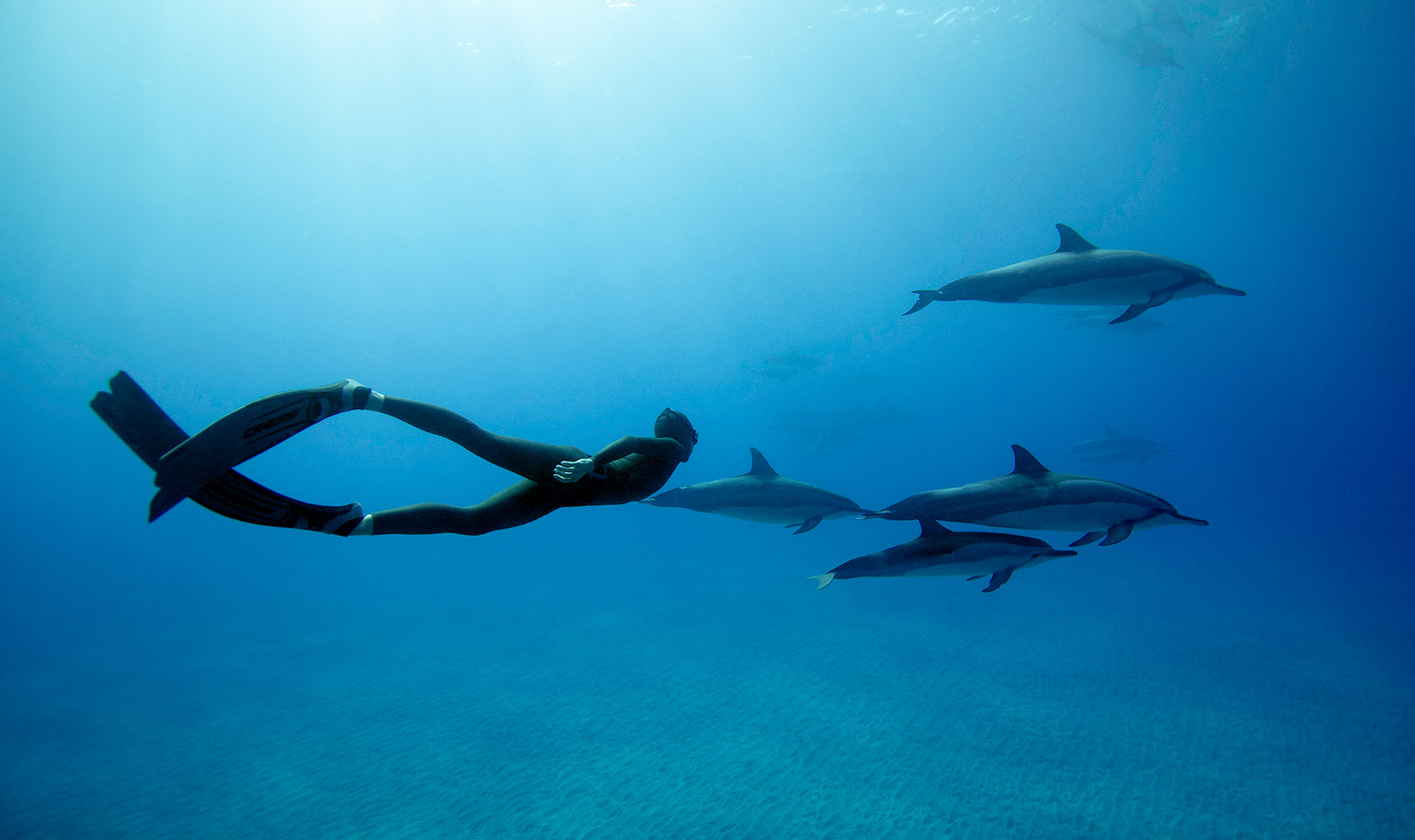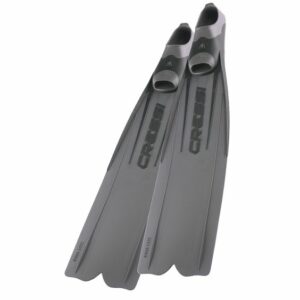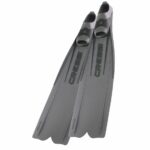
Updated March 20, 2024
The simplicity of freediving is a major alluring factor. No need for a couple of bags of heavy gear and tanks. All you need to have is a basic mask and some fins. The fins are the key. You want the most functional and energy-efficient design possible to preserve your one breath of air for as long as possible in order to achieve depth and enjoy the adventure without overexerting yourself.
There are many freediving fins on the market today specially designed for different activities and for freedivers of all skill levels that range from low-priced to very expensive. How do you figure out the right fins for you? I’ll break it down here and then introduce some of the best models for you to consider.
If you have any questions or concerns, please use the comments section at the bottom. I’d love to hear your thoughts.
For more reviews of related gear and accessories, please check out these popular posts:
Pole Spears Spearguns Spearfishing Wetsuits Lycra Dive Skins Freediving Watches Spearfishing Masks Freediving Fins Spearfishing Masks
How to Choose the Best Freediving Fins
Skill and Experience Level
Are you just getting started? How much experience do you have in freediving? A beginner would best not opt for the top-of-the-line fins. Cheaper models with polymer plastic blades will be adequate for getting your feet wet. Later when you have a better idea of your ability and style you will be able to make a better decision on the technical aspects and benefits of more expensive fiberglass or carbon fiber models
Material
The blades of freediving fins are usually made from one of three basic materials, polymer plastic, fiberglass, or carbon fiber.
- Polymer plastic blades are the least expensive and perform pretty well when new. They have desirable flexibility and are durable against bumps and scrapes. However, after some use, they have a tendency to maintain a bent shape that has lost some efficiency.
- Fiberglass blades are more expensive and not as flexible as the polymer plastic version, but maintain their shape in the long term. They are also able to withstand underwater scrapes and bumps well.
- Carbon fiber blades are the most efficient with the highest ratio of propulsion to energy used. They maintain their original shape and are very light, but also more fragile than the other two materials. Top competitive freedivers use carbon fiber blades in spite of the fact that they are much more expensive.
Budget
You will need to look at your own finances and commitment to freediving. In addition to the fins, you will need a mask and snorkel and perhaps thermal or skin protection, as well. These long-blade freediving fins start at around $80 for fins with polymer plastic blades and run up to over $600 for a pair with carbon fiber blades. Custom-fit foot pockets and design features can push it up beyond that. Keep in mind that the most important factor is good technique. When you have developed that to a certain level, then the higher-tech fins will be of more use to you. A basic guideline is that:
- polymer plastic = the cheapest
- fiberglass = mid-range
- carbon fiber = the most expensive
Getting a Good Fit
A snug comfortable fit is essential to have an efficient finning technique. If the foot pocket is loose, efficiency and wasted energy will be lost. When purchasing the best practice is to try them on, if possible. If not, do your best to understand the sizing chart. Also, keep in mind that some manufacturers expect that you will be prepared to wear a neoprene sock which can fill in the gap for an oversized foot pocket. The sock can also provide thermal protection and may make for a more comfortable fit.
Separate Foot Pockets and Blades
There are systems in which blades are detachable from foot pockets. In such cases, it is possible to buy them separately and combine them. This will allow you to replace a component while retaining the one you would like to still use, for example when one component is worn out or unsuitable for your current style or ability. You could also use blades and foot pockets that are different brands. This option is more expensive than the purchase of standard nondetachable models.
Blade Stiffness
Freediving fins are available with varying degrees of blade stiffness. The level of stiffness suitable depends on body type and amount of muscle. Generally speaking taller divers produce weaker propulsion than shorter-legged divers making longer blades more effective. Most divers will find soft to medium stiffness suitable. Divers with very weak propulsion will likely prefer soft blades.
Best Freediving Fins Review
- Mako Freedive Hunter
- Mares Pure Instinct Razor Pro
- Beuchat Mundial One
- Rob Allen Scorpia
- Cressi Gara 3000
- Mako Competition Freediver
- Omer Stingray Carbon
- Maverick C4 Falcon
Best for beginners
- Material: polymer plastic
- Interchangeable blade design: no
- Stiffness option: no
- Many sizes available
- Comfortable foot pocket
- Rating: 4.4
- Price: $
Pros: good value for the low price
Cons: can get bent over time
- Best for beginners
- Material: polymer plastic
- Interchangeable blade design: yes
- Stiffness option: no
- V-shaped tips
- Comfortable foot pocket
- Rating: 4.5
- Price: $$
Pros: superior design and well constructed
Cons: sizing may be a little large
- Best for beginners
- Material: polymer plastic
- Interchangeable blade design: no
- Stiffness option: no
- High-quality materials
- Stabilizers integrated into foot pocket tips and on the blades
- Fishtail fin shape guides the blade more efficiently in the water
- Rating: 5
- Price: $
Pros: low priced, good value for the money
Cons: can get bent over time
- Best for beginners
- Material: polymer plastic
- Interchangeable blade design: no
- Stiffness option: no
- Large size selection
- Teflon and neoprene blade coating
- Camouflage coloration for hunting
- Soft EPDM rubber foot pocket
- Rating: 4.5
- Price: $$
Pros: high performance for a moderate price
Cons: sizing may be a little large
- Best for beginners
- Material: polymer plastic
- Interchangeable blade design: no
- Stiffness option: no
- 3 material molding process
- Comfortable foot pockets with or without diving socks
- Cressi fin bag is included
- Rating: 4.5
- Price: $$
Pros: low priced with bag included
Cons: can get bent over time
- Best for intermediate level
- Material: fiberglass (10% fiberglass & 90% borealis)
- Interchangeable blade design: yes
- Stiffness option: yes (soft and medium)
- Can upgrade blades to other fiberglass or carbon components
- Several materials used in comfortable foot pockets
- Many sizes available
- Rating: 4.7
- Price: $$
Pros: low priced for great features
Cons: blades scratch easily
- Best for advanced level
- Material: carbon fiber
- Interchangeable blade design: yes
- Stiffness option: yes (soft, medium, and hard)
- 3D camouflage finish
- Lightweight
- Comfortable foot pockets
- Many sizes available
- Rating: 5
- Price: $$$$$
Pros: top performance for spearfishing
Cons: very expensive, scratch easily
- Best for advanced level
- Material: carbon fiber
- Interchangeable blade design: yes
- Stiffness option: yes (soft, medium, and hard)
- Lightweight
- High-quality materials and design
- Comfortable foot pockets
- Rating: 4.5
- Price: $$$$
Pros: good for spearfishing
Cons: expensive, scratch easily
Freediving Fins Comparison Table
For more reviews of related gear and accessories, please check out these popular posts:
Pole Spears Spearguns Spearfishing Wetsuits Lycra Dive Skins Freediving Watches Spearfishing Masks Freediving Fins Spearfishing Masks
Feedback and Comments
I hope you found this post on freediving fins exciting and useful. If you have any questions or ideas, please feel free to share them in the comments section. If there is no comments section directly below, click here: >>comments<<















